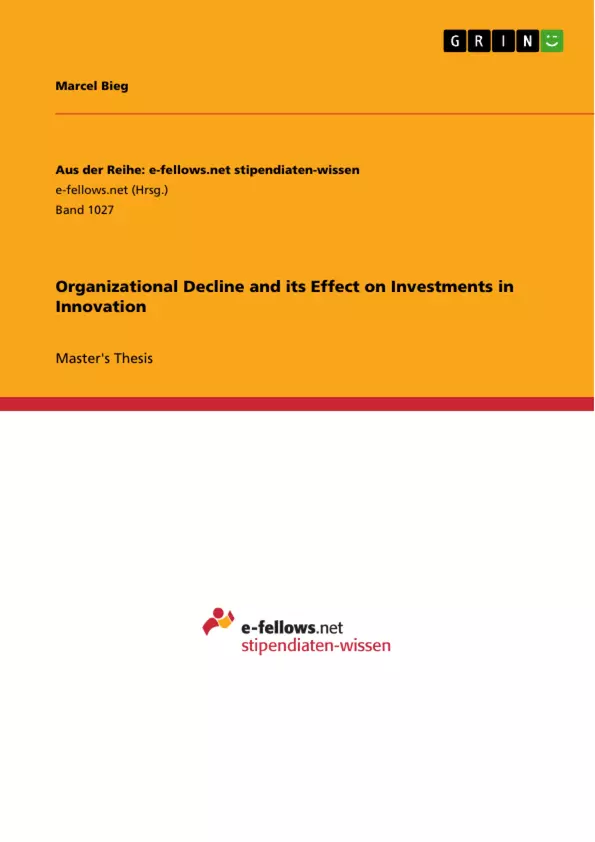In times of an increasingly unstable global economy, the topic of organizational decline and its effect on innovative activities becomes more and more important. This study aims at contributing to the ongoing academic discussion of whether performance decline facilitates or inhibits investments in innovation. In order to do so, the paper draws on the opposing predictions of the behavioural theory of the firm as well as the threat-rigidity theory and discusses their implications with respect to the thesis topic. More specifically, by investigating a sample of 803 Japanese manufacturing firms from 2008 to 2012, this study explores how organizational decline in terms of performance below aspirations, firm’s threat of bankruptcy, and organizational slack affect decision making about R&D search intensity.
Inhaltsverzeichnis (Table of Contents)
- Introduction
- Organizational Decline
- Organizational Innovation
- Problem Statement and Research Questions
- Analysis Plan and Value Added
- Structure of the Study
- Theoretical Foundations of the Decline-Innovation Relationship
- Necessity is the Mother of Rigidity
- Necessity is the Mother of Invention
- Necessity - Mother of Invention or Rigidity?
- Linking Organizational Decline and Innovative Activities
- The Moderating Effect of Threat of Bankruptcy
- The Moderating Effect of Organizational Slack
- Research Design and Methodology
- Research Design
- Sample Selection and Data Collection
- Variables
- Analysis Procedure
- Results
- Univariate Analysis
- Bivariate Analysis
- Multivariate Analysis
- Discussion and Conclusion
- Theoretical Implications
- Practical Implications
- Limitations and Future Research
- Conclusion
- References
- Appendix
Zielsetzung und Themenschwerpunkte (Objectives and Key Themes)
This study delves into the relationship between organizational decline and investments in innovation, aiming to contribute to the ongoing academic debate on whether performance decline facilitates or inhibits such investments. It examines the conflicting predictions of the behavioural theory of the firm and the threat-rigidity theory, exploring their implications in relation to the thesis topic. By analyzing a sample of Japanese manufacturing firms, the study seeks to understand how various aspects of organizational decline, such as performance below aspirations, threat of bankruptcy, and organizational slack, influence R&D search intensity.
- The impact of organizational decline on innovative activities.
- The contrasting predictions of the behavioural theory of the firm and the threat-rigidity theory.
- The moderating effects of threat of bankruptcy and organizational slack on the decline-innovation relationship.
- The role of R&D search intensity in the context of organizational decline.
- The implications of the findings for future research on the decline-innovation relationship.
Zusammenfassung der Kapitel (Chapter Summaries)
The study begins with an introduction that outlines the research problem, the research questions, the analysis plan, and the structure of the study. It proceeds to delve into the theoretical foundations of the decline-innovation relationship, exploring the opposing perspectives of the behavioural theory of the firm and the threat-rigidity theory. The research design and methodology are presented, detailing the sample selection, data collection, variables, and analysis procedure. The results section analyzes the data through univariate, bivariate, and multivariate analyses. Finally, the discussion and conclusion section examines the theoretical and practical implications of the findings, addresses limitations, and suggests avenues for future research.
Schlüsselwörter (Keywords)
The main keywords and focus topics of the study include organizational decline, innovation, R&D search intensity, behavioural theory of the firm, threat-rigidity theory, threat of bankruptcy, organizational slack, Japanese manufacturing firms, and performance below aspirations. The study explores the relationship between these concepts, investigating how organizational decline affects investments in innovation and the moderating effects of various factors on this relationship.
- Citar trabajo
- Marcel Bieg (Autor), 2014, Organizational Decline and its Effect on Investments in Innovation, Múnich, GRIN Verlag, https://www.grin.com/document/283559



